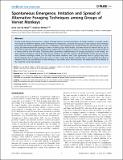Files in this item
Spontaneous emergence, imitation and spread of alternative foraging techniques among groups of vervet monkeys
Item metadata
| dc.contributor.author | van de Waal, Erica | |
| dc.contributor.author | Whiten, Andrew | |
| dc.date.accessioned | 2012-10-17T08:31:01Z | |
| dc.date.available | 2012-10-17T08:31:01Z | |
| dc.date.issued | 2012-10-10 | |
| dc.identifier | 30926511 | |
| dc.identifier | e892b5b9-dc61-4c56-ad61-e73a9f4dd94f | |
| dc.identifier | 84867378275 | |
| dc.identifier | 000312385200067 | |
| dc.identifier.citation | van de Waal , E & Whiten , A 2012 , ' Spontaneous emergence, imitation and spread of alternative foraging techniques among groups of vervet monkeys ' , PLoS ONE , vol. 7 , no. 10 , e47008 . https://doi.org/10.1371/journal.pone.0047008 | en |
| dc.identifier.issn | 1932-6203 | |
| dc.identifier.other | RIS: urn:38EDEDFB5230B4F44F913D1CBA6A2152 | |
| dc.identifier.other | ORCID: /0000-0003-2426-5890/work/65013958 | |
| dc.identifier.uri | https://hdl.handle.net/10023/3186 | |
| dc.description.abstract | Animal social learning has become a subject of broad interest, but demonstrations of bodily imitation in animals remain rare. Based on Voelkl and Huber's study of imitation by marmosets, we tested four groups of semi-captive vervet monkeys presented with food in modified film canisters (“aethipops’). One individual was trained to take the tops off canisters in each group and demonstrated five openings to them. In three groups these models used their mouth to remove the lid, but in one of the groups the model also spontaneously pulled ropes on a canister to open it. In the last group the model preferred to remove the lid with her hands. Following these spontaneous differentiations of foraging techniques in the models, we observed the techniques used by the other group members to open the canisters. We found that mouth opening was the most common technique overall, but the rope and hands methods were used significantly more in groups they were demonstrated in than in groups where they were not. Our results show bodily matching that is conventionally described as imitation. We discuss the relevance of these findings to discoveries about mirror neurons, and implications of the identity of the model for social transmission. | |
| dc.format.extent | 7 | |
| dc.format.extent | 220334 | |
| dc.language.iso | eng | |
| dc.relation.ispartof | PLoS ONE | en |
| dc.subject | Evolutionary biology | en |
| dc.subject | Birds | en |
| dc.subject | Chimpanzees Pan-Troglodytes | en |
| dc.subject | Culture | en |
| dc.subject | Animals | en |
| dc.subject | Mirror neurons | en |
| dc.subject | Mechanisms | en |
| dc.subject | Premotor Cortex | en |
| dc.subject | QL Zoology | en |
| dc.subject.lcc | QL | en |
| dc.title | Spontaneous emergence, imitation and spread of alternative foraging techniques among groups of vervet monkeys | en |
| dc.type | Journal article | en |
| dc.contributor.institution | University of St Andrews. School of Psychology and Neuroscience | en |
| dc.contributor.institution | University of St Andrews. ‘Living Links to Human Evolution’ Research Centre | en |
| dc.contributor.institution | University of St Andrews. Institute of Behavioural and Neural Sciences | en |
| dc.contributor.institution | University of St Andrews. Centre for Social Learning & Cognitive Evolution | en |
| dc.identifier.doi | https://doi.org/10.1371/journal.pone.0047008 | |
| dc.description.status | Peer reviewed | en |
This item appears in the following Collection(s)
Items in the St Andrews Research Repository are protected by copyright, with all rights reserved, unless otherwise indicated.

